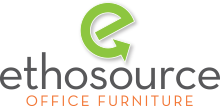We all have that one colleague who is always late to the morning meeting or that team member who always makes a negative comment. But let’s be honest. We’re all guilty of our own bad habits. They’re inevitable when you spend so much of your time working in the same way or place.
But that’s why your workplace plays such an important role in preventing or squashing those habits, and more importantly, in starting better, healthier ones! It’s a new year, so why not start fresh — everyone will thank you for it.
If you or your team members are guilty of any of the following top four bad office habits, we’ve got tips on how employees can break them — and how leaders can create an environment that facilitates better working patterns.

-
Sitting ALL Day
You’ve heard it before: sitting is killing you. We don’t mean to be dramatic, but it really isn’t ideal — especially since studies show the average person who works in an office sits up to 15 hours a day. With numbers like that, it doesn’t matter how fit you are; sitting can wreak havoc on your body. Risks of depression, neck and back pain, weight gain, diabetes, blood clots, and more all drastically increase with the lack of movement. But standing all day isn’t the solution either. It can result in extra pressure on your legs and veins, which are dangerous to the cardiovascular system; not to mention, standing just makes you tired in general without any physical benefits.
The Solution…
Leaders: While ergonomic office chairs like the one in Ethosource’s extensive selection are scientifically designed to minimize a lot of these health risks, the most effective way to combat the consequences is movement. Sit-to-stand desks aren’t just trendy — their whole intention is to minimize employee discomfort and fatigue. They offer complete user control in height and position, and they work in conjunction with both modern systems furniture or independently as flexible workspaces. Incorporate them into your office design as a private or shared desk option, so that employees have the ability to switch up how they work when they need to.
Workers: Keep in mind the big power of little breaks. Stand up and walk as you take a quick call, make a point to say hi to another employee across the office, or just go refill your water — even if it isn’t empty. One study showed that adding two minutes of walking to every hour can decrease a person’s risk of dying by 33%. Wooah.
-
Not Setting Weekly Goals / Getting Distracted
Winging it will only get you so far. It tends to lead to unproductive multi-tasking, distractions, and wasted time trying to figure out what to work on and when. If you’re not focused on one task and it’s deadline, you end up bouncing from one thing to the next — checking emails, jumping in on that conversation your coworkers are having, etc. It’s a lot easier to get overwhelmed without a plan.
The Solution…
Leaders: Setting and sticking to goals is also a lot more successful when you have the right accessories. White boards, cork boards, desk organizers, shelving/filing panels — make sure your team has everything they need to visualize their goals and stay organized enough to achieve them. Also consider incorporating privacy panels or room dividers into various areas in the office. They can be added directly into individual work areas with systems furniture, or you can utilize mobile privacy/acoustic screens that allow employees to drown out noise and signal to others that they’re in the zone.
Workers: Put your tasks/goals in a place you can see them. Write them down, hang them up. Consider setting time limits for various projects so you can encourage yourself to stick to it and move forward. Nothing feels quite as good as checking those items off your list. And make it a new habit to turn your phone off for certain periods throughout the day to resist tempting social media checks. Seek places in the office that offer more distraction-free environments — maybe it’s a meeting room or huddle space.
-
Working through Lunch
Similar to not taking breaks, skipping lunch is a bad habit for your health and productivity. We know you think it’s more efficient to just have lunch at your desk as you continue to power through, but it actually has more harmful effects than you think. These breaks are not only important for your health, but your overall focus and mood too. A lunch break helps you refresh and sustain your energy throughout the day.
The Solution…
Leaders: The best way to encourage team members to get up and away from their desk is to give them spaces to do so. Does your office have a cafe or lounge where employees would want to eat? Consider creating shared spaces, both inside or outside, that can encourage collaboration and socialization. These things tend to be most successful when they happen naturally.
Workers: Make it an objective to get away from your desk for at least 30min at lunchtime. Set a timer and stick to it. Whether it’s meeting co-workers in the cafe or grabbing a table outside for a sandwich with a side of Vitamin D. Not everyone will be on the same schedule, so make sure you set your own.
-
Poor Communication
Communication makes the world go ‘round. And while it’s constantly being enhanced by technology, those same tools are also pushing us further apart. Many teams are now working in hybrid structures with some or all employees working remotely to some degree. This makes “water cooler talk” and collaboration a lot different.
The Solution…
Leaders: Set certain times throughout the workday to touch base with your team on whatever platforms you use. Set up “coffee talks” or “happy hours” to give employees a chance to share their struggles and success, or just say how they’re doing. Give them all the tools they need to communicate no matter where they are with workspaces and meeting rooms that are fully equipped for conferencing. Make sure remote employees have access to the same technology and opportunities that in-person workers do. And find ways to encourage casual conversations, personal shares, etc. more often.
Workers: Suggest some of the ideas above to your leadership. And you should set specific times to check in with colleagues and teammates too. Be more proactive in your communication. Over communicating is almost always better than the alternative.
To learn more about how to break old office habits and start fresh in 2022 with a design that fits your company goals, contact Ethosource today.
